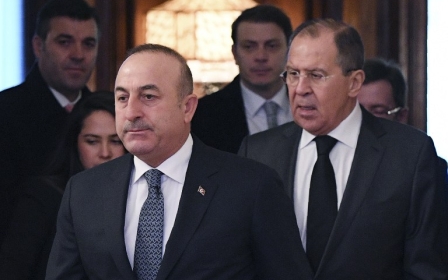Why Ahrar al-Sham is fighting itself - and how this impacts the battle for Syria

The strong Islamist movement Ahrar al-Sham is going through an internal existential crisis which may have significant impacts not only on the group itself but also on the local dynamics of the Syrian conflict as well.
The disagreements among the movement’s leaders peaked on 10 December, when 16 local factions of the group united to form a new sub-faction called Jaish al-Ahrar, under the leadership of Ahrar al-Sham's former chief, Hashim Al Sheikh.
Some attributed these differences to ideological rivalries.
Pragmatic cadres want to turn the movement into a more politically accepted Islamist group by distancing themselves from Salafi-Jihadi puritanism and increasing cooperation with the West and other Syrian rebel factions. But a hardliner current within Ahrar al-Sham embraces Salafi-Jihadi puritanism and seeks to merge with other radical groups like Jabhat Fatah al-Sham. Hardliner officials also want to distance themselves from Turkey, the West and their Syrian allies.
READ: The political solution that Syria needs
Others close to the group have viewed this rift as a power struggle and a clash of strategies.
Whether the reason is one or the other - or a mix of both which is most likely - the future dynamics of the conflict depend on the way the movement deals with these divisions.
Organised and powerful
Ahrar al-Sham, also known as Harakat Ahrar al-Sham al-Islamiyya, is a coalition of multiple Islamist and Salafist units that coalesced into a single brigade in order to fight against the Syrian regime.
The movement was founded five years ago by Hassan Abboud and other former Islamist prisoners of the Assad regime, released from Sednaya Prison soon after the uprising began in 2011. It was initially based in the Idlib governorate but quickly expanded throughout Syria although it remains most active in north and west of the country.
On a broader scale, this rift within Ahrar al-Sham is further deepening the divisions and fragmentation among rebel groups that are already in a disastrous state.
Ahrar al-Sham is considered the most organised and powerful rebel group with an estimated 20,000 fighters. The movement generates money from controlling crossing points with Turkey, but it depends mainly on foreign support from Turkey and Qatar.
Like the internal schism now, the group faced a similar existential threat before when more than 40 of the group’s top leaders were killed on 9 September 2014 in a gas attack during a top-level meeting in one of their most secured underground bases in Idlib.
However, the group was able to overcome the attack by reemphasising collective leadership through its Shoura Council (Consultative Council).
Underlying issues
Ahrar al-Sham’s participation in the Turkish-led military operation against the Islamic State (IS) in Syria and its merger talks with Jabhat Fateh al-Sham, the rebranded former al-Qaeda affiliate Jabhat al-Nusra, are the two main underlying issues that have recently brought the rivalries within the group to the fore.
On 20 September, Ahrar al-Sham’s Shoura Council issued a fatwa (religious ruling) permitting the fight alongside the Turkish coalition against IS. The fatwa led to a division within the organisation as some opposed it because the necessary religious conditions for such cases, in their opinion, had not been met.
As a result, at least one faction, al-Ashidda, several individuals and two Shoura Council members, defected.
READ: How Russia stops Syria and Turkey from clashing
Additionally, the recent merger negotiations between Jabhat Fateh al-Sham and Ahrar al-Sham, among other groups, was a highly divisive issue within the movement.
While the hardliner wing was in favour of the proposed merger as a means to strengthen rebel unity, pragmatists in the group refused it over fears of losing support and being labelled as a terrorist group which comes with a heavy price.
Although similar merger negotiations took place over the past few years, talks of an alliance surfaced again after the creation of Fateh al-Sham and the severing of its ties with al-Qaeda, which was previously reported as the main obstacle to the merger.
Unprecedented behaviour
Unlike previous cases in which the person who received the majority of support took the lead, electing a new leader for the organisation last November was the last straw that led to significant internal polarisation.
Usually, the group’s leader is elected by the majority of the Shoura Council’s 22 members, and rules for one year.
Regardless of how and when the group’s infighting is resolved, it will likely have significant impact, not only on the movement but on the broader conflict.
Although Ali al-Omar, who serves as the group’s current leader, received the majority of the votes in November, several hardliners protested against his election. Eight Shoura members suspended their membership, explaining that their decision resulted from the deadlock in solving the pending problems within the movement.
The hardliners refused to accept anyone other than the two candidates they had proposed -- the former leader of the movement Hashim Al Sheikh or its military commander Abu Saleh Tahhan.
This unprecedented behaviour came after the hardliners had accused the pragmatists of sidelining them in order to change the identity of the group and make it more accepted regionally and internationally.
READ: The cause that Aleppo died for
The tension escalated further with this month’s creation of the new sub-faction Jaish al-Ahrar, which threatens to escalate the group into a full-scale rift and a messy split.
The hardliners refused to refer to their creation of the subdivision as a split. Instead, they described it as a move to keep the movement from disintegrating by bringing together all those who are planning to defect.
Significant impact
Regardless of how and when the group’s infighting is resolved, it will likely have significant impact, not only on the movement but on the broader conflict.
It seems that the hardliners, who hold a minority within the Shoura Council, are trying to overrule a majority vote by demonstrating that they are much stronger among the movement’s armed fractions.
If this rift is solved through negotiations and the hardliners succeed in securing more influence and better terms within the movement, then the group will likely become paralysed every time there is a need for a strategic decision. The hardliners will have learned that they can block decisions by throwing a fit.
However, if the movement fails to resolve this division, it will likely lead to more defections of both individuals and factions, or even a full split between Jaish al-Ahrar and the movement, which is less likely.
Fragmentation of rebels
Jabhat Fatah al-Sham will likely benefit from any of these outcomes. If Ahrar’s rift remains unresolved, the former al-Qaeda affiliate is likely to gain more fighters from the split movement, which could turn in it into the strongest rebel group.
But equally, a resolution could also benefit Jabhat Fatah al-Sham, giving its allies within Ahrar more influence to secure good relations and maintain close coordination between the two organisations, both of which will continue to complicate the US-led efforts to eliminate Jabhat Fatah al-Sham.
On a broader scale, this rift within Ahrar al-Sham is further deepening the divisions and fragmentation among rebel groups that are already in a disastrous state. The rebels' significant recent loss of eastern Aleppo to the Syrian regime, has further limited their power and territories.This rift, thus, will likely increase the tension and infighting within rebel groups and decrease the level of support channelled by their backers. It will also complicate the ongoing attempts to unify the rebels’ efforts in one coalition, which is much needed to be able to hold their grounds and prevent what happened in Aleppo from happening elsewhere.
The possibilities of a positive outcome are slim. The movement, however, could still make the best out of this situation and take bold measures to continue sidelining its hardliners and adopting an accepted national agenda, which could bring it closer to other rebel groups and their Western backers and allow it to play a bigger political role in the future.
- Haid Haid is a Syrian columnist and researcher and a Chatham House Associate Fellow. Focus: Security policy, conflict resolution, Kurds and Islamist movements. He tweets @HaidHaid22.
The views expressed in this article belong to the author and do not necessarily reflect the editorial policy of Middle East Eye.
Image: An image grab taken from a video uploaded in 2013 by Syria's Ahrar al-Sham rebel group (AFP)
This article is available in French on Middle East Eye French edition.
New MEE newsletter: Jerusalem Dispatch
Sign up to get the latest insights and analysis on Israel-Palestine, alongside Turkey Unpacked and other MEE newsletters
Middle East Eye delivers independent and unrivalled coverage and analysis of the Middle East, North Africa and beyond. To learn more about republishing this content and the associated fees, please fill out this form. More about MEE can be found here.







